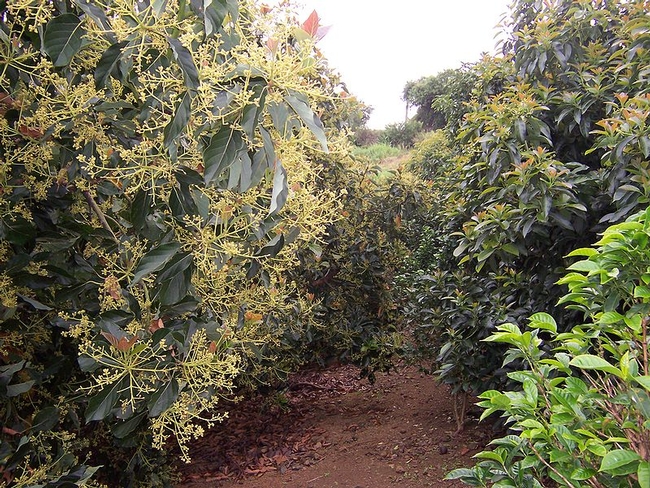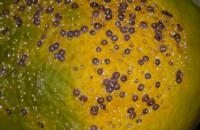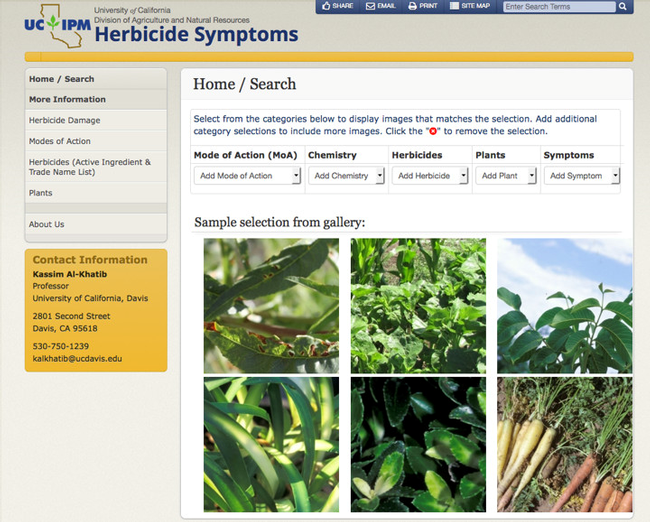From the UC Blogosphere...
When a Butterfly Looks Like a Penguin
A sharp-eyed youngster noticed the resemblance. When entomologist Jeff Smith, a volunteer associate at the Bohart Museum of...
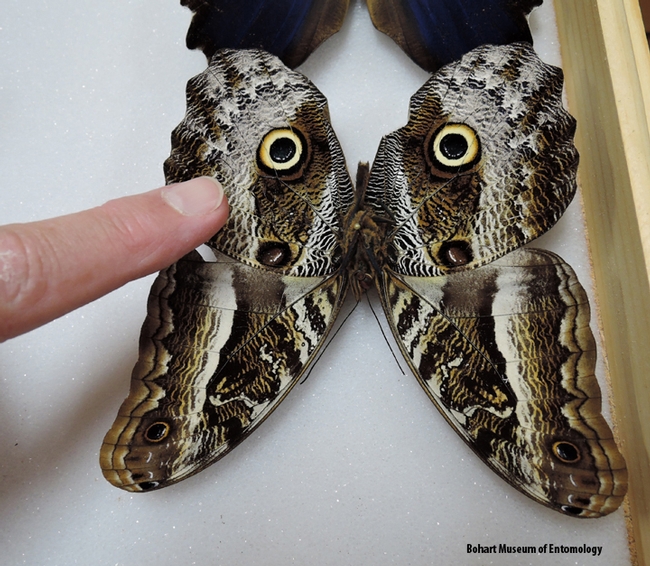
This is an owl butterfly, genus Caligo. (Photo by Kathy Keatley Garvey)
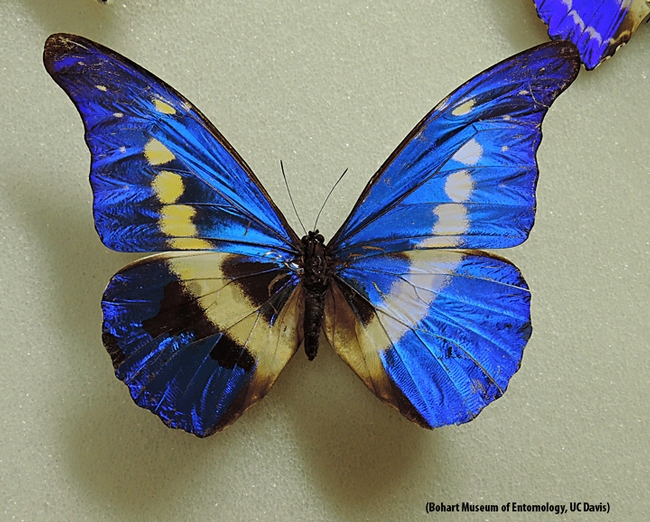
The spectacular Morpho cypress cyanide. (Photo by Kathy Keatley Garvey)
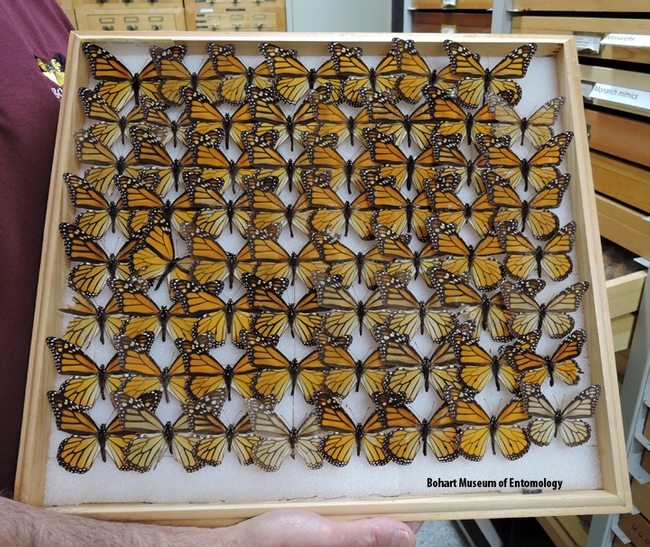
If you haven't seen a single monarch yet this year, you'll see plenty of them at the Bohart Museum of Entomology. (Photo by Kathy Keatley Garvey)
California coffee can be grown amidst avocado trees
Planting coffee shrubs right next to avocado trees is allowing a Central Coast farmer to grow a commercial crop of coffee without using any additional land, water or fertilizer, reported Parma Nagappan in TakePart.com.
The farmer, Jay Ruskey was working with UC Agriculture and Natural Resources advisor Mark Gaskell when they had a "eureka moment," the story said. Coffee bushes can benefit from the environment created by an avocado plantation.
"I went through lots of cycles of plantings looking at options for using unused land," Rusky said. "Interplanting works for a lot of reasons, and coffee fits perfectly with avocados because it has similar nutrition requirements."
Americans' coffee is typically grown in tropical areas of Hawaii, and Central and South America. Gaskell, who worked with coffee growers for Central America for several years prior to joining UC in 1995, approached Ruskey with the idea of growing coffee in 2001.
“My job is to help small farms with problem solving, so I'm always looking for these kinds of synergies,” Gaskell said of the interplanting technique. “Commercial water rates are high, so ‘How are we going to get the most efficient utilization of land and water?' is at the back of every grower's mind.”
Gaskell said it is important to note that coffee also does just fine by itself in open field planting as long as it is irrigated. It doesn't require avocado interplanting for success, but avocado interplanting is an additional opportunity for coffee growing in California.
In 2014, Coffee Review rated Ruskey's coffee - sold under the name Good Land Organics - among the top 30 in the world.
The publication's top ranking of Good Land Organics has made coffee associations elsewhere sit up and take notice of the potential for a high-quality, domestic crop, the Take Part article said.
“All of a sudden I'm thrown into the spotlight of the coffee world because I'm a disruption, which is something it needs, because it does not have a lot of research going on, like with other crops,” Ruskey said.
California Red Scale Males are Already Flying!
Once again, we are having hot dry weather conditions in the San Joaquin Valley. This means that the first male California red scale are already flying in Kern and Tulare counties (Biofix) and degree days are accumulating 1-2 weeks ahead of 'normal'. Unless we get cooling weather, this means that the first generation of crawlers will be emerging earlier than usual. See degree day calculations for Kern and Tulare counties.
New Herbicide Symptoms Photo Repository
New UC IPM photo repository shows plant damage from herbicides
—Tunyalee Martin, UC Statewide IPM Program
—Chris Laning, UC Statewide IPM Program
Identifying nontarget crop and ornamental plant damage from herbicides has become much easier with the launch of a new online photo repository by the Statewide IPM Program, University of California Division of Agriculture and Natural Resources.
Herbicides applied to manage weeds may move from the site where it was applied in the air or by attaching to soil particles and traveling as herbicide-contaminated soil. When an herbicide contacts a nontarget plant, a plant it was not intended to contact, it can cause slight to serious injury. Herbicide injury also occurs when the sprayer is not properly cleaned after a previous herbicide application. Herbicide residue can be found in the spray tank, spray lines, pumps, filters and nozzles so a sprayer must be thoroughly cleaned after an application. Dry herbicide particles can be redissolved months later and cause herbicide damage to plants. Economic damage includes reduced yield, poor fruit quality, distorted ornamental or nursery plants, and occasionally plant death.
Accurately diagnosing plants that may have herbicide injuries is difficult. In many cases, herbicide symptoms look very similar to symptoms caused by diseases, nutrient deficiencies, environmental stress and soil compaction. Plant disease symptoms such as mottled foliage, brown spots or stem death and plant pests such as insects or nematodes cause foliage to yellow and reduce plant growth similar to herbicide injury.
Dr. Kassim Al-Khatib, weed science professor at UC Davis and director of the UC Statewide Integrated Pest Management Program (UC IPM), has gathered nearly a thousand photos of herbicide-damaged plants, drawn from his own and others' research. The images are cataloged to show damage that can occur from 81 herbicides in more than 14 specific herbicide modes of action, applied in the field to demonstrate the symptoms or when known herbicide spray has drifted onto the plant.
Each image is characterized with the name of the plant, mode of action of the herbicide, and notes the specific symptoms of damage. Together these photos provide a comprehensive archive of damage to over 120 different crops and ornamental plants by known herbicides, which users can easily compare with what they see in the field.
Also included in the repository is information about the modes of action of various herbicides and an index of example herbicide trade names and active ingredients. Users can learn how unintended injury from herbicide occurs from misapplication and carryover from previous crops in addition to drift and herbicide-contaminated tanks.
The repository can be found at http://herbicidesymptoms.ipm.ucanr.edu. Increased knowledge about what causes herbicide damage and how it occurs can lead to fewer cases of herbicide injury occurring through drift or herbicide-contaminated tanks. Using the repository can increase the skill to correctly identify plant damage. Correctly identifying damage as herbicide injury and not from a plant pest or nutrient deficiency can prevent unnecessary applications of pesticides or fertilizers. Fewer applications can lessen the risk of harm of pesticides and fertilizers to people and the environment.
Lacewings! Lacewings! Lacewings!
There it was. A beautiful green lacewing, family Chrysopidae, resting on a yellow Iceland poppy in our bee garden. It...

A green lacewing lands on an Iceland poppy. (Photo by Kathy Keatley Garvey)
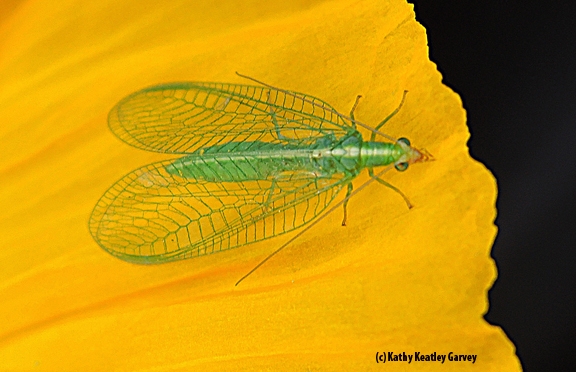
Membranous wings of the green lacewing. (Photo by Kathy Keatley Garvey)
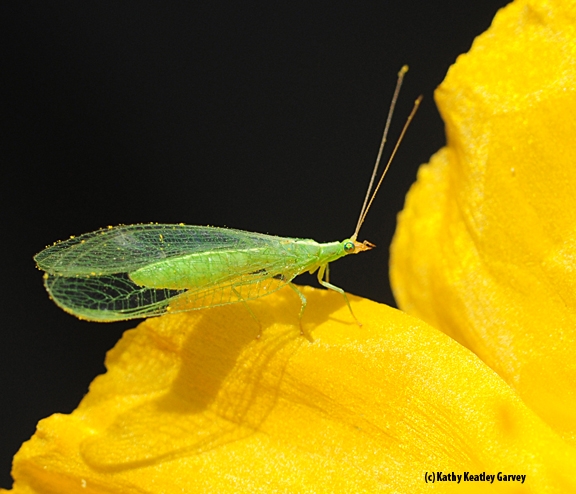
This lacewing was checking its surroundings. (Photo by Kathy Keatley Garvey)



